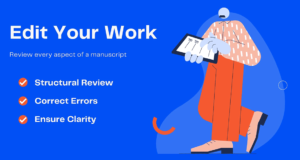
A Writers Resource
For Writers 50 Common Publishing Terms
Here’s a definition list of 50 common publishing terms we think every writer should know. If you plan to self-publish you will find this list particularly useful as you prepare your manuscript for publication.
Know What’s Next
It is so important to take control of your work. Whether you intend to self-publish or work with a traditional publisher, you should know as many publishing terms as you can because the more you know, the greater your opportunities. Stay informed so that you can get the book you want and publish the way you want. Be in control of your your manuscript.
Advance reader copy (ARC). An early version of the book sent out to media outlets for possible reviews and interviews.
Agent. A liaison between a writer and editor or publisher who advocates for his or her client (writer). Agents usually take a 10-15% commission from the advance and royalties.
All rights. Situation in which an author sells all rights to a work. Not recommended for writing that could have reprint potential.
Audience Building. Audience building is the process used to identify, engage, cultivate or expand your list of potential readers.
Author Landing Page
An author landing page is a digital marketing strategy used to promote, and author and their work. The landing page is a call to action (CTA) intent on encouraging a visitor to purchase the author’s book.

Author Pages. An author’s page contains a crafted bio about the author. The write-up allows readers to feel closer to the author because they get to know something about the personal life of the author. Places where you might find an author’s page include Amazon, Goodreads, Barnes & Noble and other sites where the author sells their book.
Author’s Bio. A sentence or brief paragraph about the writer, which sometimes includes their education, work experience or details about their expertise.
Back Cover. The back cover is the part of your book that summarizes the contents to entice the reader to buy your book. If done right, the description is so good that the reader will buy your book.
Back Matter. Back matter refers to the pages following the main text of a book such as the appendix, afterword, index or bibliography.
Blurb. The book description written to promote a book, generally found on the back of book covers or dust jackets. Also called flap copy or jacket copy.
Body Matter. Body matter refers to the main book text that represents your story. Simply put, it’s everything that isn’t front or back matter.
Finished Editing: Bring it All Together
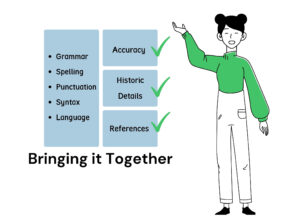
Book Cover Design. Book cover design involves the arrangement of images and text to depict the mood or theme of your book. Most often, the cover, when done right relays a single message. It’s important to get that message right to attract your target readers to your book.
Book design. Book design is the process of transforming your manuscript to a consumable book. The major parts of book design are its exterior and interior components. The exterior involves designing a book cover in a way that attracts people to pick up the book. When it comes to the interior, it means setting up your pages in the way that readers have come to expect when they open a book.
Book Doctoring. A Book doctor is generally a writer who fixes writing issues found in a manuscript. They look for big-picture problems like structure and flow problems. For novels, they do even more in terms of helping develop the plot, give guidance on structure and provide writing tips to help guide the vividness of your work.
Book Preparation. Book preparation is the process of transforming your manuscript into a publishable book. A properly prepared book has a cover, formatted interior pages and if it is made ready for self-publishing it also means the book is copyrights, given an ISBN number for all formats and cataloged. The most important part of book prep is ensuring the book is ready to sell in eBook and/or printed formats.
Let Us Design Your Book Cover

Catalog in Publication (CIP). The library of congress states, “The main purpose of a CIP record is to record the bibliographic data elements of a work and facilitate access to it in library catalogs.”
Category Fiction. A term used to include all genres of fiction.
Comprehensive Edit. Includes all stages of editing, which includes substantive editing, copyediting and proofreading.
Copy Editing (Editing). Copyediting is the process most people think of when they talk about editors. A copy editor finds errors, and notes inconsistencies in the copy (manuscript).
Copyright. A copyright documents ownership of a literary work. It registers the details of ownership and reduces unmerited challenges to ownership.
Critiquing service. An editing service in which writers pay a fee for comments on the salability or other qualities of their manuscript. A book critique is an objective, non-biased summary and evaluation of your manuscript.
Developmental Edit. A developmental editor helps authors plan their manuscript. The work may include guidance on structure, writing style or rewrites. One of the overall goals of this type of editing is to help the author meet the story objectives and to ensure the book they write is marketable to their target audience.
Draft. A draft is any version of your manuscript not marked as final. It is more often than not considered the first completed version of your book.
Let Us Critique Your Manuscript
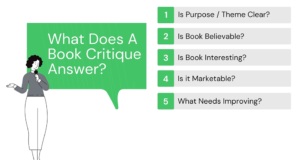
Writing a book is hard work. After a writer finishes a manuscript, there is still a long way to go before it is ready to publish. If you don’t plan to use an editor before submitting your work to an agent or publisher it is always a good idea to have your work critiqued to find out if you have any major problems. A critique can be the difference between failure and success.
Dust Jacket. A dust jacket is the removable paper cover used to protect a hardcover book. Most dust jackets have a cover illustration, a book synopsis on the front inside flap, and an author bio on the inside back flap. Along with the standard book blub, reviews and other options on the back.
Editing. Editing includes reading a manuscript for clarity, organization, believability and consistency. The goal of editing is to improve the manuscript, which may require, rewriting sentences, deleting unnecessary paragraphs, rearranging sections of a chapter, or adding details to make your writing more interesting.
Evaluation. A manuscript evaluation looks at the purpose of the written work and then determines whether or not it clearly defines it purpose. Such reviews evaluate how well the manuscript is organized, how well it flows and the general understandability of the work. Other aspects of the evaluation discuss the overall content, style, voice and for fiction plot, characterization, setting, dialog and any aspect of the book contributing to the overall readability of the work.
We Can Format Your Book
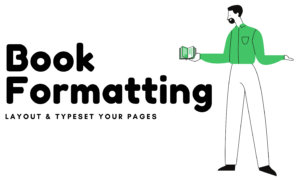
Front Cover. The front cover is the first of the physical parts of a book. The primary goal of its design is to sell the book by intriguing the right readers to pick it up. The essential elements of a front cover include title and author name. Optional elements include the subtitle (if there is one), photos or illustration, background images or graphics.
Front Matter. The pages preceding the main text of a book such as the title page dedication or table of contents.
Galley. A galley is a copy of the book once it’s been through the layout and design stages. It is not the production print but is used to provide a final opportunity to review or make changes before the book goes to print. Galley copies can be bound proofs and are sometimes used as advance reader copies (ARCs).
Genre. General classification of writing determined by style, subject along with other characteristics used to group an author’s work.
Ghostwriter. A ghost writer is someone who writes articles, speeches, stories, or books for pay based on the ideas, expertise, experience or research of the credited author. Most ghostwriting projects are a work made for hire where the author is the person or organization paying for the work. The author also gets the credit for that work and maintains all copyrights to that work.
We’re Ready to Edit Your Book
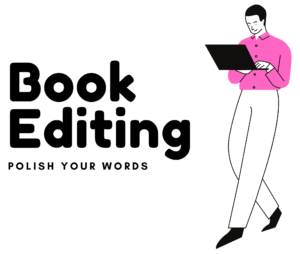
Hardcover. A hardcover is composed of two cardboard sheets connected by fabric, laminated paper or leather. The cover is placed around the pages of a bound book to form a hardback book. Plain hardcovers generally have a protective dust jacket wrapped around them.
Hook. Aspect of the work that sets it apart from others and draws in the reader and hopefully results in a purchase.
ISBN. An International Standard Book Number (ISBN) is a unique identification number assigned to all published books. A book’s ISBN along with a bar code contains specific data about the published work including the country where the book was published, the publisher, edition, and more. The ISBN is also used by bookstores and libraries, which means a separate identification number is required for eBooks, hardbacks, paperbacks and audiobooks for the same title.
published books. A book’s ISBN along with a bar code contains specific data about the published work including the country where the book was published, the publisher, edition, and more. The ISBN is also used by bookstores and libraries, which means a separate identification number is required for eBooks, hardbacks, paperbacks and audiobooks for the same title.
Literary Services. provide extended resources to writers to help them improve their work, edit their manuscripts, submit proposals to agents and ultimately to publish a book with a traditional publisher or to self-publish.
Matte Vs. Glossy. Whether a book is paperback or hardcover a choice is made to use a matte or glossy finish. A glossy finish is super-shiny and a tiny bit reflective. A matte finish is low-shine and typically non-reflective.
Narrative nonfiction. A non-fiction classification that uses the style of a fiction novel to tell a real story. Also called creative nonfiction or literary nonfiction.
Some Facts about Self-Publishing
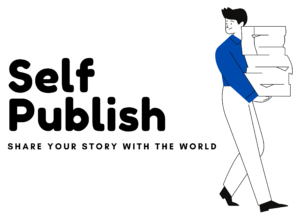
- You may not make any money from your book
- The author has to pay for everything upfront
- Allows you to keep all your rights
- Requires a lot of marketing to payoff
Page Layout. refers to the arrangement of text, images, and other objects on a page. When it comes to magazines, newspapers, books, websites, and other types of publications page layout techniques are used to create a professional appearance.
PDF. In book printing projects, a PDF is the digital file format used to specify exactly what the printed book will look like to include the fonts, point size, line spacing and images.
Print-On-Demand. A type of publishing option where books are printed individually when they are ordered. This is an economical alternative to traditional publishing, which typically requires you to print a few hundred books at once.
Proof. In publishing lingo, “proof” means a pre-print sample of a book. Typically, your publisher or printer provides a proof for review before large quantities of the book is printed. It is the final opportunity to review the book and catch any typos or formatting issues before the book goes to print.
Proofreading. Proofreading is a careful reading to search for and correct typographical errors. It means the proofreader will go through the final draft to correct small issues such as missing punctuation, typos, or grammar and spelling errors.
Need an Editor? Try Our Literary Services!
Literary Services help authors create publish worthy manuscripts and that’s why editing is so important. When you submit your work for critique, evaluation, or comprehensive editing you strengthen your manuscript, thus making it ready to for publication, or submission to your agent or publisher. Your editor is a partner to help you shape your writing success because they work with you to create a well written, error free book.
Royalty. Royalties are payments made to authors based on the sales of their books. Publishers will undertake a contract with their authors outlining what the Royalties for book sales will be. Although there are no hard-and-fast “standard” for royalties, they range from 5% of sales to 15% of sales. Therefore, if a publisher agrees to pay an author 10% royalty on gross sales, and the author’s book retails for $10, the publisher will be paying the author $1 for every book sold.
Self-Publishing. Self-publishing means the author pays for manufacturing, production, and marketing of their book and keeps all income derived from the book sales.
Spine. Finished books that are more than 130 pages long also need spine text that shows the main title and author’s last name as part of the cover design.
Not a Writer. Why Not Hire a Ghostwriter?
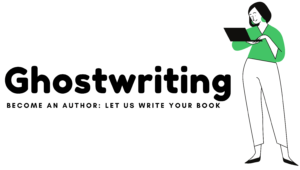
Substantive Edit. Substantive editors do everything copyeditors and proofreaders do and more. They start with the big picture and study every aspect of a manuscript to see whether the content is a coherent whole. Next, they recommend structural, style and content changes which includes corrections to grammar, spelling and other technical aspect that needs editing.
TOC. Table of contents
Trim Size. In book printing the trim size represents the actual size of the page after it has been trimmed. When a book is printed the printer uses large sheets of paper and then cut them to the size of your book.
Typesetting. Adobe defines typesetting as “the arrangement of words to create an optimal reading experience. Typesetting is the way that text is composed using individual types — the symbols, letters, and glyphs in digital systems. It’s a crucial part of the world of design that requires an understanding of fonts, corresponding font sizes, and line spacing. Good typesetting and typography is invisible.”
Typography. Typography involves the selection of fonts and the arrangement of those fonts by point size, as well as vertical and horizonal spacing to create visually appealing work. For most non-fiction and fiction books, typography is essential to the design and success of the book cover.
Work for hire. A contractual agreement in which a writer agrees to compose material for a publisher, author or company for an agreed amount of money. This means selling all rights to the in perpetuity.

